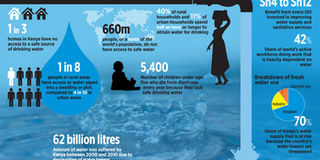Cholera outbreak kills 216 while 13,000 others have been admitted in two years

Since 2014, at least 216 people have died of Cholera and 13,000 more admitted to hospitals following the outbreak affecting half the country. GRAPHIC | LISA WAMUGUNDA | NATION MEDIA GROUP
What you need to know:
Health ministry has mapped out close to 12 counties that are currently reporting cases of cholera outbreak.
The two-year outbreak started in 2014 and has been recurring since then.
Wajir, Marsabit, Tharaka Nithi, Tana River, Meru, Busia and Nandi counties are experiencing the first ever wave of the outbreak.
- Cholera surveillance report revealed that the highest number of cases are being reported among people above 46 years old.
- Cholera is caused by a bacterium, Vibrio cholerae.
At least 216 people have died and close to 13,000 others admitted following a cholera outbreak that has affected more than half of the country.
The Ministry of Health has mapped out close to 12 counties that are currently reporting cases of cholera outbreak.
The ministry also says 16 counties have managed to contain the epidemic.
The two-year outbreak started in 2014 and has been recurring since then.
However, the ministry is yet to give the latest statistics of deaths and admissions since January this year.
Just like the number of deaths and admissions, the number of counties that have reported the disease has doubled. In June last year, 81 deaths were recorded and this has since almost tripled.
HANDLING FOOD AND HYGIENE STANDARDS
While urging the public to take extra caution while handling food and to observe high hygienic standards, Health Principal Secretary Nicholas Muraguri said some counties were reporting cases of cholera for the first time when others were dealing with a perennial issue.
Dr Muraguri said Wajir, Marsabit, Tharaka Nithi, Tana River, Meru, Busia and Nandi counties are experiencing the first ever wave of the outbreak, meaning these counties have been reporting cases of cholera since the 2014 outbreak.
“Garissa County is reporting the second wave; Nakuru the third wave, Siaya and Migori the fourth while Nairobi is reporting the fifth wave,” added Dr Muraguri.
He also said a cholera surveillance report by the ministry revealed that the highest number of cases are being reported among people above 46 years old, followed by those between six and 15.
The least number of cases are reported among Kenyans aged 36 to 45.
CHOLERA SYMPTOMS
The PS said cholera outbreak is largely due to the mushrooming of unhygienic food outlets and improper screening of food handlers. Screening of the handlers is a function of county governments.
“We urge the public to be extra cautious while handling food and to observe high hygienic standards,” said Dr Muraguri.
According to the ministry, cholera is characterised by more than four episodes of diarrhoea within 12 hours. This is followed by severe dehydration and can lead to death if untreated.
“We spend between Sh2,000 to Sh5,000 to treat one cholera patient with antibiotics and fluids. We also provide drugs and chlorine tablets to county governments to handle outbreaks,” he told the Nation by phone Tuesday.
Dr Muraguri added that the national government has stepped up efforts to provide support, including providing doctors and laboratory reagents for quick and correct diagnosis of cholera.
Affected counties, according to the ministry, have since set up “cholera treatment units” for case management as well as provided family members of cholera patients with medication to prevent infections, also called chemoprophylaxis.
Cholera is caused by a bacterium, Vibrio cholerae. In its most severe form, it is characterised by an explosive outpouring of fluids from the body through vomiting and/or diarrhoea within hours of infection such that, if not treated appropriately, can lead to death.
If not properly handled, the bodily fluids can contaminate food and water.
County governments, especially those in affected areas, have banned selling of food in efforts to contain the disease.





